Fitbit Versa 3 vs Charge 5: Deciding the Best Fitbit
Fitbit Versa 3 vs Charge 5: The Ultimate Comparison
Fitbit Versa 3 vs Charge 5: Fitbit has solidified its standing as a prominent participant in the fitness tracker industry by providing a range of products to cater to a wide range of fitness and lifestyle requirements. Fitbit Versa 3 and Fitbit Charge 5, two of its most popular models, have features that are intended to improve your experience with fitness and health. The design, smart features, battery life, price, user experience, durability, and connection of both devices will be thoroughly compared. You should know by the end of this essay which gadget best suits your individual fitness objectives.
For those looking for a full-featured smartwatch, the Fitbit Versa 3 is the perfect choice thanks to its bigger AMOLED display and more sophisticated smart capabilities like voice assistants and on-wrist call answering. The Fitbit Charge 5, on the other hand, is concentrated on sophisticated health tracking and has features like ECG and EDA sensors that offer detailed information about stress levels and heart health. While the Versa 3 has a wider range of features and is more enticing to consumers seeking both fitness monitoring and smartwatch capabilities, the Charge 5 boasts a thinner, lighter design that is appropriate for all-day usage.
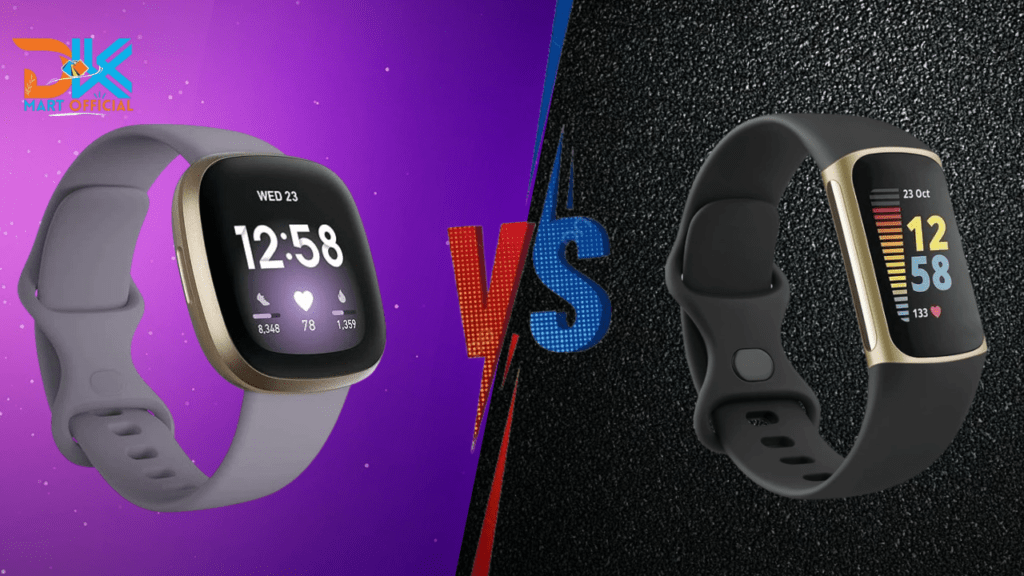
Fitbit Versa 3 vs Charge 5: Design and Display
Fitbit Versa 3 vs Charge 5: With its stylish, smartwatch-inspired design and roomy 1.58-inch AMOLED display with a sharp 336 × 336 pixel resolution, the Fitbit Versa 3 stands out. In addition to providing vivid images, this high-resolution screen guarantees legibility even in direct sunlight. An improved user experience is provided to users by the larger display size, which makes it easier to provide detailed information and allows for smoother interaction with the device’s functions. Furthermore, the Versa 3’s always-on display mode adds to convenience by enabling users to quickly and easily view the clock and notifications without waking the device.
Fitbit Versa 3 vs Charge 5: The Fitbit Charge 5, on the other hand, has a 1.04-inch AMOLED display with a resolution of 260 x 170 pixels and a more compact, fitness band-style design. The screen is still quite clear and brilliant despite its reduced size, making it ideal for viewing in a variety of lighting conditions. In addition to adding to the Charge 5’s lightweight design, its streamlined shape improves comfort, making it appropriate for all-day use. Convenience is further enhanced with the Charge 5’s support for an always-on display mode, which, like the Versa 3, allows users to quickly and easily see the clock and notifications.
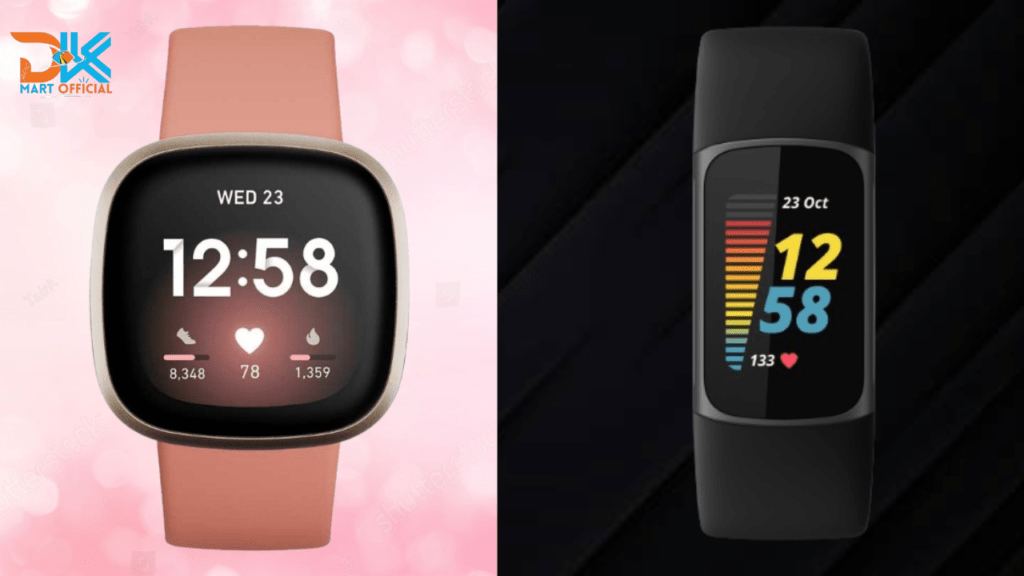
Fitbit Versa 3 vs Charge 5: Health and Fitness Tracking
Fitbit Versa 3
Heart Rate Tracking: Fitbit’s cutting-edge PurePulse 2.0 technology is used by the Versa 3 to continuously measure heart rate. This gives you access to real-time heart rate information throughout regular activities and workouts, which can improve your understanding of your cardiovascular health.
Monitoring Your Sleep: The Versa 3 offers a thorough Sleep Score every night and tracks your light, deep, and REM sleep phases with its sophisticated sleep tracking. This provides insights and patterns over time to assist users improve the quality of their sleep.
Monitoring SpO2: While you sleep, the device measures your blood oxygen levels and provides you with information about variations in your oxygen saturation. This can be especially helpful in identifying any possible respiratory problems brought on by sleep.
GPS: With built-in GPS, outdoor activities like cycling, hiking, and jogging may be tracked without a phone. After an exercise, you may check your workout intensity map in the Fitbit app and see your real-time pace and distance on the screen.
Minutes of the Active Zone: This tool encourages you to meet your weekly goals for maximum health benefits by tracking the amount of time you spend in your desired heart rate zones. Your age and fitness level determine how many Active Zone Minutes you receive.
ECG Mobile App: Users can check for atrial fibrillation (AFib) in their cardiac rhythm using the ECG app that comes with the Versa 3. You can share the on-demand readings that this tool offers with healthcare practitioners.
Handling Stress: Tools for managing and tracking your stress can help you keep an eye on it. The Versa 3 provides guided breathing exercises and measures stress levels using heart rate variability (HRV).
Monitoring Menstrual Health: Users can record symptoms, track menstrual cycles, and forecast when fertility windows and ovulation will occur. Users can monitor their general reproductive health with its assistance.
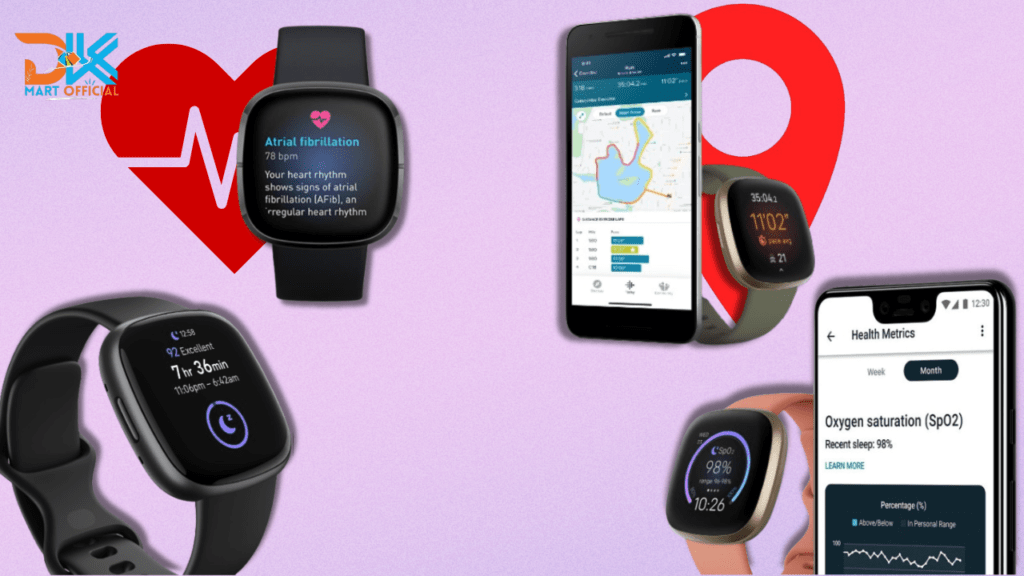
Fitbit Charge 5
Heart Rate Tracking: Like the Versa 3, the Charge 5 monitors heart rate continuously using Fitbit’s PurePulse technology. It offers comprehensive insights and up-to-date statistics on your cardiovascular health every hour of the day and night.
Monitoring Your Sleep: Using the Charge 5, you may monitor different stages of sleep and receive a Sleep Score for your advanced sleep tracking. This tool assists users in recognizing their sleep patterns and implementing the required changes for improved sleep.
Monitoring SpO2: Similar to the Versa 3, the Charge 5 monitors blood oxygen levels as you sleep, giving you vital information about the health of your respiratory system every night. It assists in locating any notable deviations that might point to medical problems.
GPS: With the Charge 5’s integrated GPS, you can track outdoor activities precisely without using your phone. Pace, distance, and route monitoring are all included, and the Fitbit app offers thorough post-workout maps.
Minutes of the Active Zone: By keeping track of the amount of time you spend in your own heart rate zones, Active Zone Minutes can motivate you to complete the suggested 150 minutes of heart-pumping exercise every week. This feature makes sure you’re working out at the appropriate intensity by adjusting to your level of fitness.
ECG Mobile App: An on-wrist ECG app on the Charge 5 evaluates your heart rhythm for AFib and provides on-demand findings that may be stored and shared with healthcare providers.
EDA Sensor: The EDA sensor, which is exclusive to the Charge 5, tracks your body’s stress response by measuring electrodermal activity. This sensor provides information on how your body reacts to stress and aids in the creation of a thorough stress management score.
Monitoring Menstrual Health: Like the Versa 3, the Charge 5 tracks menstrual health by letting users record symptoms, cycles, and fertility predictions. This tool aids users in better managing and comprehending their reproductive health.

Fitbit Versa 3 vs Charge 5: Smart Features
Fitbit Versa 3
Talking Assistants: With the Versa 3’s support for Google Assistant and Amazon Alexa, users can do a lot of things from the comfort of their wrist, such setting reminders and checking the weather or controlling smart home appliances.
Control Music: Users can download playlists from services like Deezer and Pandora, manage Spotify, and store music. Organizing your music while on the road is now convenient and doesn’t require your phone.
Notifications: Notifications for calls, texts, and different apps are shown on the Versa 3. Additionally, Android users can improve connectivity and communication without pulling out their phones by sending short replies straight from the watch.
Fitbit Payment: Fitbit Pay, a contactless payment system, makes it simple to make purchases from your watch, increasing the device’s usability on a daily basis.
Watch Faces and Apps: Users may customize their watch face and add a wide range of apps to personalize their device and access practical utilities like fitness apps and weather forecasts.
Integrated Speaker and Microphone: The watch may be used to initiate Bluetooth calls and give voice commands thanks to its integrated speaker and microphone. This functionality improves the smartwatch experience and makes it a useful tool for daily tasks.
Fitbit Charge 5
Talking Assistants: Voice assistants are not supported by the Charge 5. Because of this restriction, customers cannot control smart home appliances or issue voice orders via their fitness tracker.
Control Music: The Charge 5 does not have music control or storage options, in contrast to the Versa 3. One potential issue for individuals who prefer to listen to music while working out is that users are unable to manage playlists or control music playback on the device.
Alerts: The Charge 5 shows call, text, and app notifications, same as the Versa 3. It does not, however, allow for the sending of prompt responses, therefore participation is limited to viewing notifications.
Fitbit Pay: The Charge 5 supports Fitbit Pay for contactless payments, allowing the convenience of making purchases right from your wrist, similar to the Versa.
Apps and Watchfaces: The Charge 5’s selection of apps and watch faces is more limited than the Versa 3. This reflects its emphasis on fitness tracking rather than broader smartwatch capabilities.
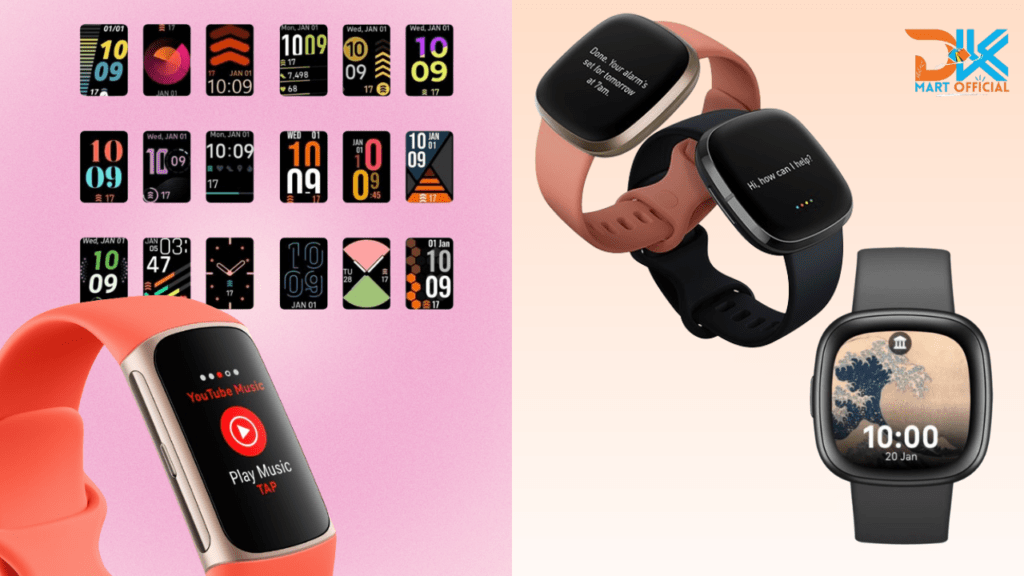
Fitbit Versa 3 vs Charge 5: Battery Life
Fitbit Versa 3 vs Charge 5: Battery life is an important issue when selecting a fitness tracker, and both the Fitbit Versa 3 and Fitbit Charge 5 provide outstanding endurance, albeit with minor changes. The Versa 3 has an impressive battery life of up to 6 days on a single charge, though this can vary based on usage patterns. It’s worth noting that features like built-in GPS and always-on display mode can have a significant influence on battery life, needing periodic recharges to ensure optimal operation.
In comparison, the Fitbit Charge 5 has a slightly longer battery life of up to 7 days, giving consumers an extra day of use before needing to be recharged. Similar to the Versa 3, excessive GPS monitoring and the always-on display feature might deplete battery life over time. Nonetheless, the Charge 5’s longer battery life is convenient, especially for customers who prefer less frequent charging periods. Finally, both devices have impressive battery life, allowing for continuous use throughout the week, with the Charge 5 significantly ahead in this regard.
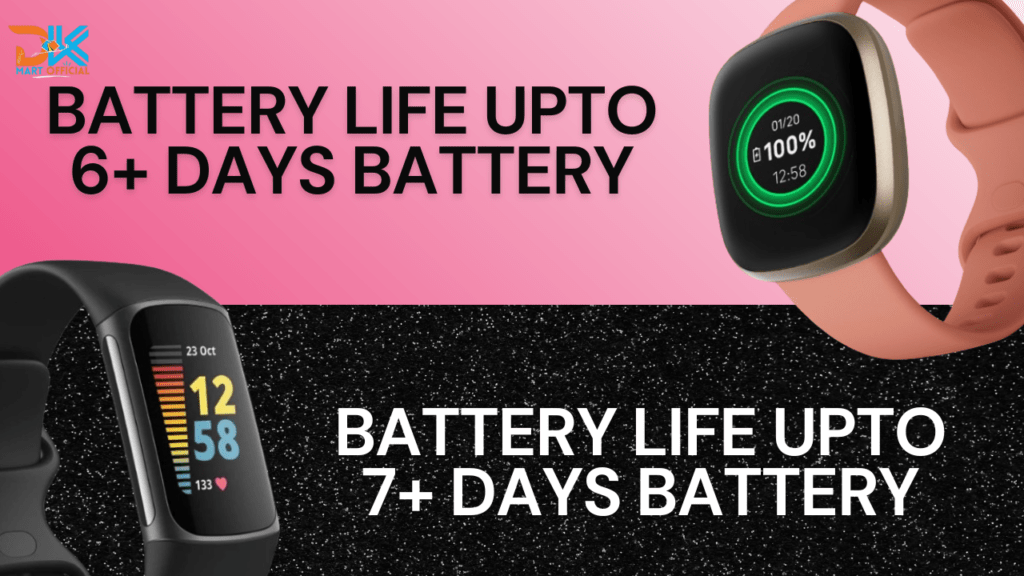
Fitbit Versa 3 vs Charge 5: Price
Fitbit Versa 3 vs Charge 5: When it comes to price, the Fitbit Versa 3 and Fitbit Charge 5 cater to a variety of budgets while offering outstanding value in their categories. The Fitbit Versa 3, with its sophisticated functionality and smartwatch-inspired design, charges a premium pricing. As of the most current update, it typically retails for around $230, reflecting its premium standing in the Fitbit range. However, pricing may vary depending on discounts and special deals, allowing budget-conscious buyers to get the Versa 3 at a lesser price.
On the other hand, the Fitbit Charge 5 is a more affordable option that does not sacrifice functionality. With a retail price of around $180, the Charge 5 represents good value, especially given its extensive health and fitness tracking capabilities. Despite being less expensive than the Versa 3, the Charge 5 still has a full feature set that caters to customers’ wellness demands, making it an appealing option for those looking for value without losing performance. Overall, the pricing approach of both devices is consistent with their respective target markets, providing flexibility to users with varied budget limitations.
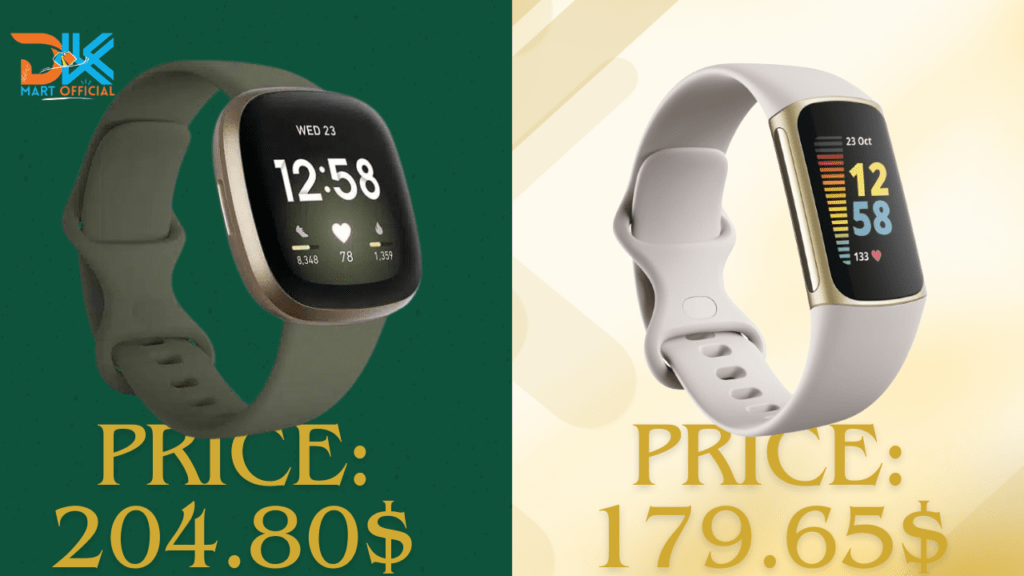
Fitbit Versa 3 vs Charge 5: User Experience and Interface
Fitbit Versa 3 vs Charge 5: The user interface is an important part of the entire user experience, and both the Fitbit Versa 3 and Fitbit Charge 5 have unique interface designs geared to different tastes and usage circumstances. The Versa 3’s bigger screen size improves interactivity and usability, making it a more immersive experience for consumers. The Versa 3’s responsive touch screen and intuitive menu layout make it simple to browse through various features and settings, making it suitable for individuals who like a more participatory experience. The device’s big screen size allows for the presentation of more information at once, ensuring that users have easy access to relevant data.
Fitbit Charge 5 uses a more simple interface, which is made possible by its reduced screen size. While the touch screen remains sensitive, the decreased display area means that less information is shown at once. However, this design choice is consistent with the Charge 5’s intended purpose as a fitness tracker, which prioritizes rapid and easy access to critical data. Users may quickly glance at vital indicators without being overwhelmed by too much information, making the Charge 5 excellent for individuals who value simplicity and efficiency in their wearable devices. Overall, whether customers prefer a rich, engaging experience or a more plain interface, the Versa 3 vs Charge 5 provide distinct design approaches that cater to a variety of preferences.
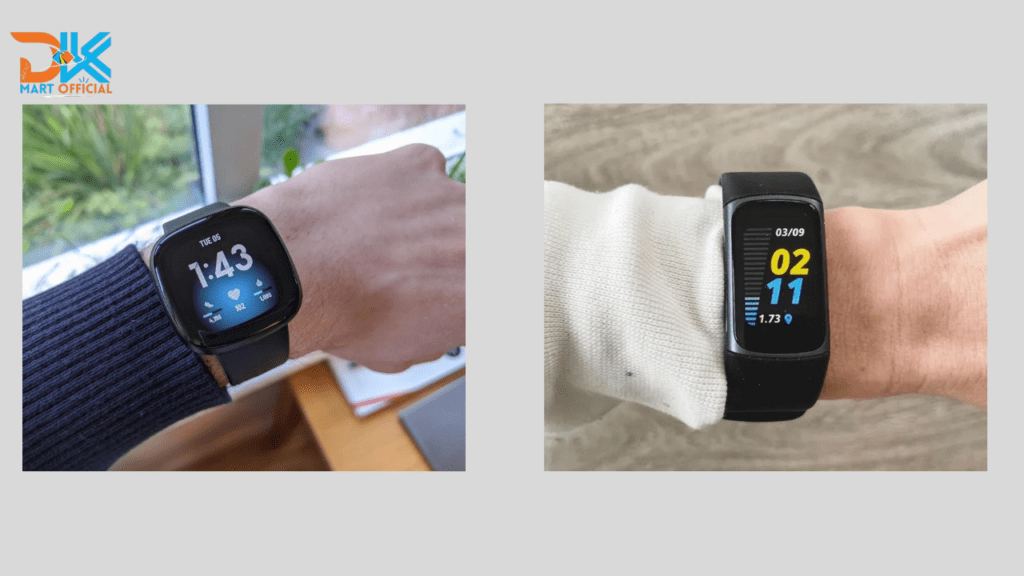
Fitbit Versa 3 vs Charge 5: Durability and Water Resistance
Fitbit Versa 3 vs Charge 5: Both the Fitbit Versa 3 and Fitbit Charge 5 are built to survive the rigors of daily use, with tough materials and water-resistant designs that can sustain immersion up to 50 meters. This level of water resistance makes them ideal partners for swimming or refreshing showers without sacrificing performance. The Fitbit Versa 3 has a strong structure with durable components such as an aluminum shell and Corning Gorilla Glass 3 on the display. This combination ensures resistance against impacts and scratches, increasing the device’s longevity and preserving its beautiful appearance even after extended use.
Similarly, the Fitbit Charge 5 is designed to be durable, with an aluminum case and a strong glass display that can resist regular wear and tear. These high-quality materials add to the Charge 5’s durability, ensuring that it remains intact and functioning across a variety of activities and settings. Whether customers indulge in hard workouts or outdoor experiences, the Versa 3 and Charge 5 provide peace of mind thanks to their sturdy build, allowing them to focus on their fitness objectives without fear of harming their devices.
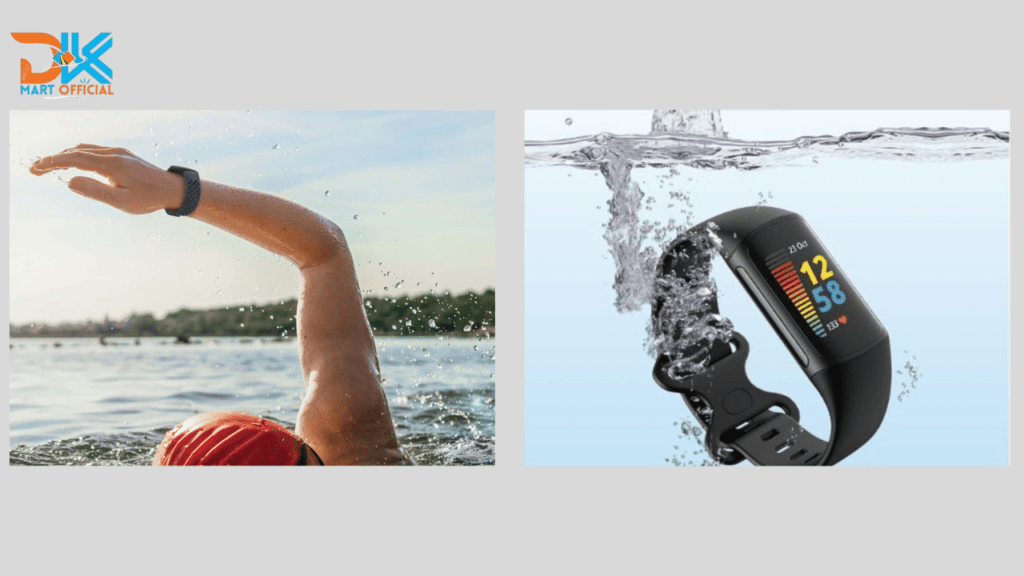
Fitbit Versa 3 vs Charge 5: Compatibility and Connectivity
Fitbit Versa 3 vs Charge 5: Both the Fitbit Versa 3 and Fitbit Charge 5 provide smooth connectivity choices, providing interoperability with a wide range of devices to meet users’ different needs.
The Fitbit Versa 3 stands out for its comprehensive interoperability with both Android and iOS smartphones. It enables simple data syncing and notification receiving via Bluetooth and Wi-Fi networking choices. Furthermore, the Versa 3’s built-in GPS and GLONASS features give exact tracking of outside activities, allowing users to track their fitness trips more accurately and reliably.
Similarly, the Fitbit Charge 5 is compatible with Android and iOS smartphones and includes Bluetooth connectivity for easy pairing and communication. While the Charge 5 lacks Wi-Fi connectivity, it compensates with built-in GPS capability, which allows for accurate tracking of outdoor activities without the need for a paired smartphone. Despite the lack of Wi-Fi connectivity, the Charge 5 remains an adaptable fitness companion, allowing customers to stay connected and informed throughout their workouts.
Overall, whether customers choose the Versa 3 or Charge 5, they can anticipate seamless connectivity and dependable tracking features to help them achieve their fitness objectives and lifestyle needs.
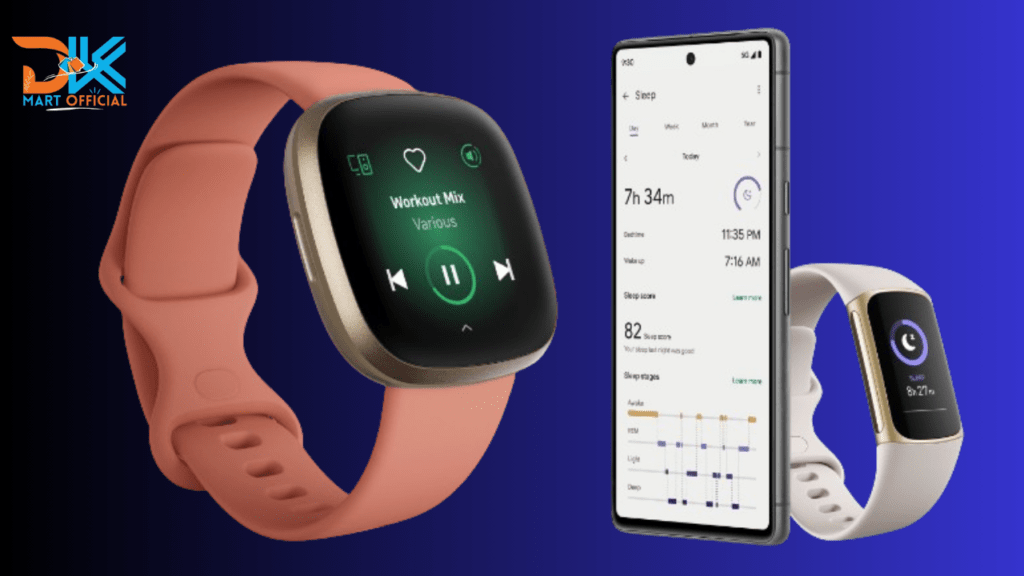
Fitbit Versa 3 vs Charge 5: Additional Features
Fitbit Versa 3 vs Charge 5: The Fitbit Versa 3 and Fitbit Charge 5 both provide unique extra capabilities to help customers with their health and wellness journeys.
With its extra capabilities, the Fitbit Versa 3 takes a holistic approach to well-being. Guided Breathing Sessions offer customers guided breathing exercises based on their heart rate, which promotes relaxation and stress reduction. On-Wrist Calls capability allows customers to answer or reject calls directly from their wrist, ensuring they stay connected even while working out or doing other activities. Furthermore, the Versa 3 includes Customizable Widgets, which allow users to personalize their watch with a selection of widgets and shortcuts, allowing them to easily access important information and features.
The Fitbit Charge 5, on the other hand, focuses health insights and activity tracking through its distinct added features. The Health data Dashboard allows users to view detailed health data such as heart rate variability and skin temperature fluctuations, providing greater insights into their general well-being. The Stress Management Score function assesses users’ daily stress levels using heart rate, sleep, and activity data, allowing them to manage stress more effectively. Furthermore, the Charge 5 has over 20 Exercise Modes, allowing users to precisely track specific workouts and adjust their fitness regimens to their unique objectives and tastes.
Overall, whether customers prioritize leisure and connectivity with the Versa 3 or seek comprehensive health insights and activity tracking with the Charge 5, both devices offer value.
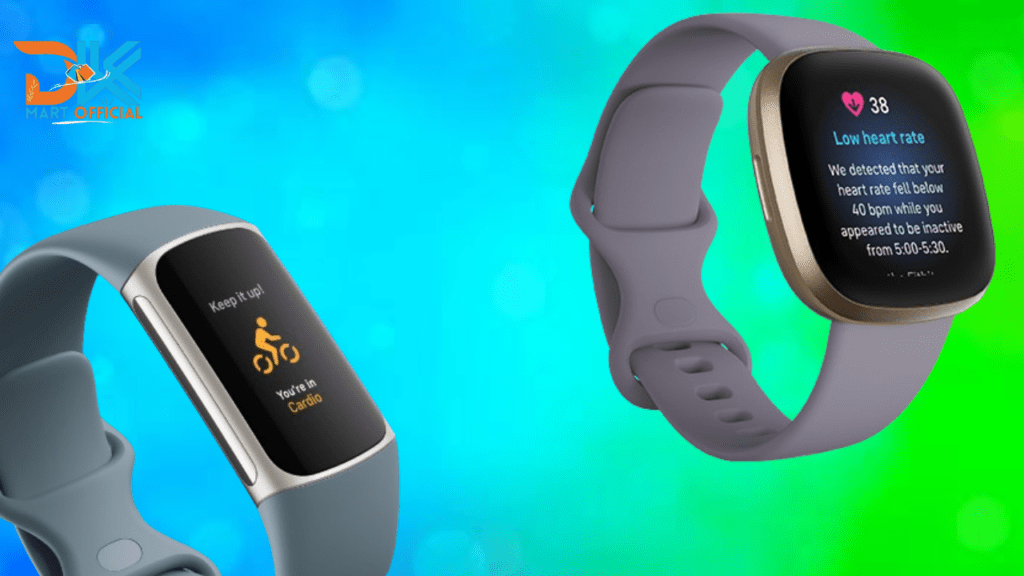
Here’s a Table Outlining The Pros and Cons of Fitbit Versa 3 vs Charge 5:
| Fitbit Versa 3 vs Charge 5: Pros | Fitbit Versa 3 vs Charge 5: Cons |
| Fitbit Versa 3 | |
| Full-Featured Smartwatch: Provides a wide range of smartwatch capabilities, including as voice assistants, music control, and configurable widgets. | Higher Price: Typically costs more than the Charge 5, making it less affordable for some consumers. |
| Large AMOLED Display: A spacious 1.58-inch AMOLED display with rich colors and excellent resolution improves visibility and engagement. | heavy Design: The larger display and smartwatch-inspired design may feel heavy on smaller wrists or during strenuous exercise. |
| Built-in GPS: Allows for accurate tracking of outdoor activities without the need for a paired smartphone, resulting in convenience and freedom. | Battery Life: While acceptable, the battery life of up to 6 days may be less than that of some specialized fitness trackers. |
| Guided Breathing Sessions: Provides guided breathing exercises based on heart rate to promote relaxation and stress reduction. | App Availability is restricted: Despite offering apps and customisable watch faces, the choices may be restricted when compared to other smartwatches. |
| On-Wrist Calls: Users may answer or reject calls straight from their wrist, which improves connectivity and convenience. | Dependency on Smartphone: Some services, such as music storage and quick replies, require an associated smartphone to function properly. |
| Fitbit Charge 5 | |
| Slim and Lightweight Design: With a sleek and lightweight design, it’s comfortable to wear all day without feeling cumbersome. | Limited Smartwatch Features: The lack of voice assistants and music control limits the device’s usefulness beyond fitness monitoring. |
| Advanced Health Tracking: Provides detailed health indicators such as heart rate variability and skin temperature fluctuations, as well as complete insights into overall health. | Smaller Display: Some users may find the 1.04-inch display too small, particularly when viewing detailed information or notifications. |
| Stress Management Features: An EDA sensor for recording stress response and a Stress Management Score help users manage stress effectively. | No Built-in Music Storage: Lacks music storage and control choices, forcing customers to rely on a paired smartphone for music playback during workouts. |
| Long Battery Life: Provides up to 7 days of battery life on a single charge, allowing for longer use without regular recharging. | Less Customization: While apps and watch faces are available, the options may be limited when compared to full-fledged smartwatches such as the Versa 3. |
Conclusion:
Fitbit Versa 3 vs Charge 5: Finally, the Fitbit Versa 3 and Fitbit Charge 5 are strong challengers in the fitness tracker industry, providing to different customer preferences and lifestyle needs. The Versa 3 succeeds as a full-featured smartwatch, with a bigger AMOLED display, advanced smart capabilities, and a plethora of configurable options. The Charge 5, on the other hand, stands out for its emphasis on advanced health tracking, which provides insights into critical health data as well as stress management solutions suited to users’ needs.
When comparing the two devices, consumers must evaluate their specific needs and usage scenarios. The Versa 3’s extensive feature set and smartwatch-inspired design make it an appealing option for those looking for a versatile gadget that fits smoothly into their daily life. In contrast, Charge 5’s emphasis on health insights and activity tracking appeals to those that prioritize wellness monitoring and fitness optimization.
Fitbit Versa 3 vs Charge 5: Finally, whether users prefer connectivity and mobility with the Versa 3 or comprehensive health insights and activity tracking with the Charge 5, both devices provide exceptional value and capability. The option between the two is based on personal preferences, lifestyle requirements, and fitness goals, allowing customers to find the best fit for their specific needs inside the Fitbit ecosystem.

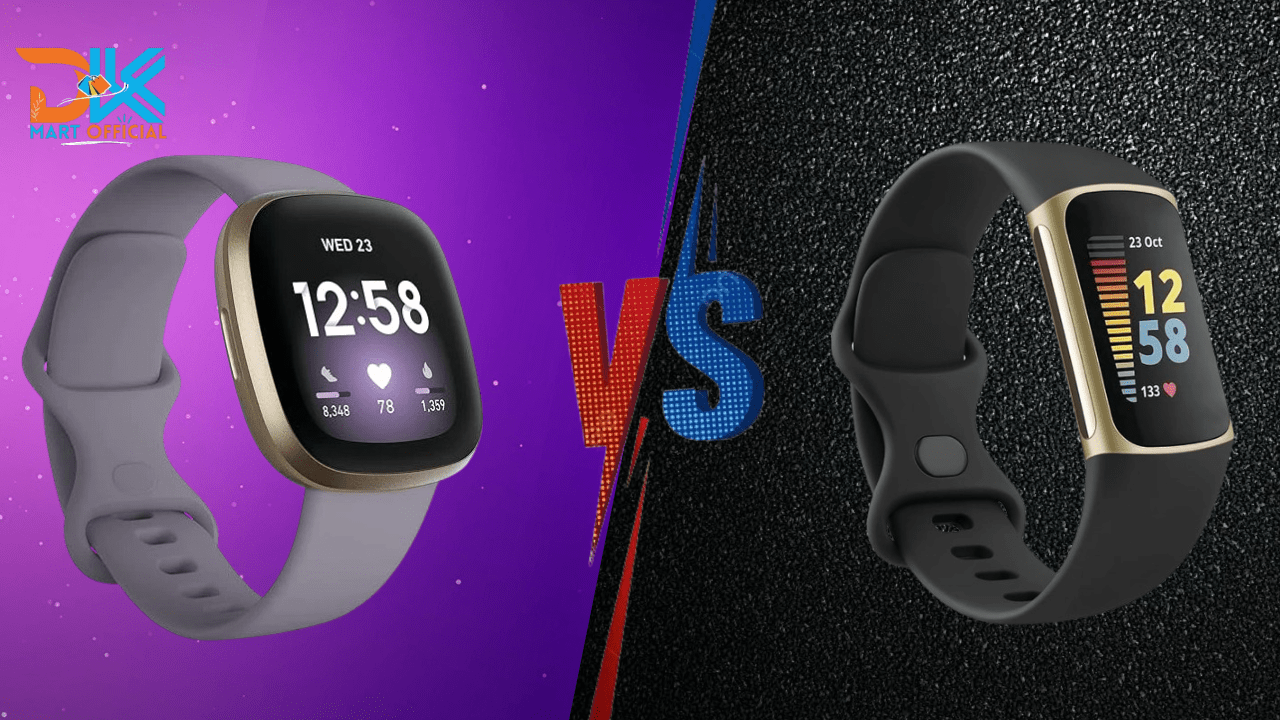
1 thought on “Fitbit Versa 3 vs Charge 5: Deciding the Best Fitbit”